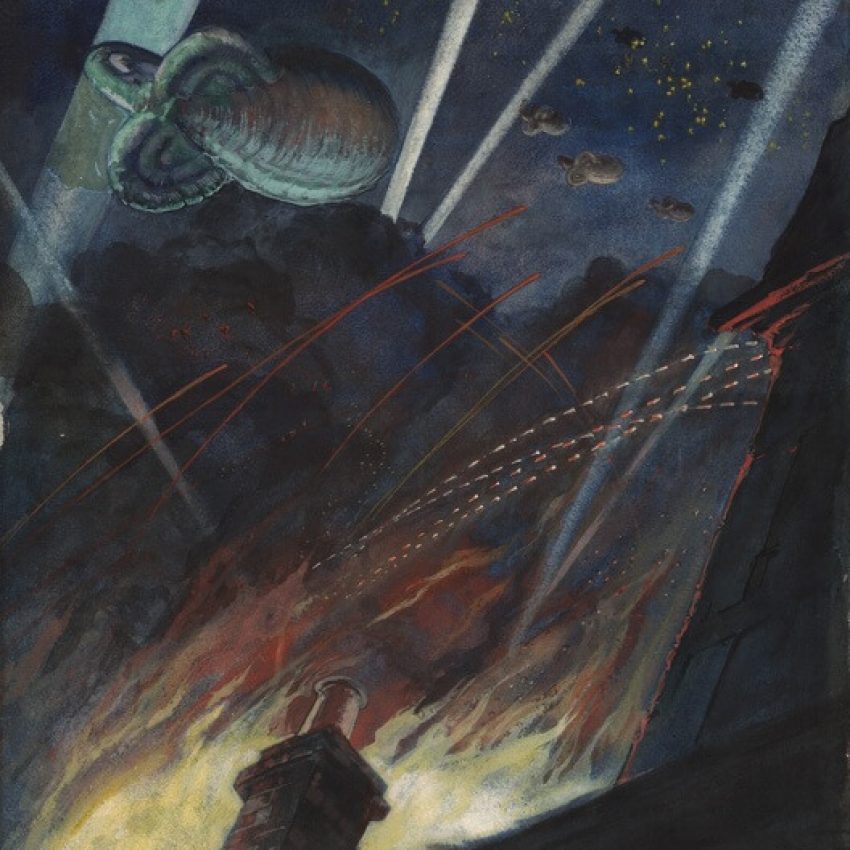
Born in England Keene spent his youth in South aftrica and most of his life in Canada but studied art in London, Paris and Munich. He came from an artistic background: his mother was a prominent photographer (the first woman to be elected to the Royal Photographic Society) and his father and artist and craftsman. When he was only 17 Louis and his father held a joint exhibition of their paintings in South Africa. Keene travelled throughout his life,in Europe but also Egypt, Turkey, Morocco, Hong Kong, Mexico and Siberia. Throughout his army career Keene was an avid artist, using watercolour, ink and pencil, and India ink and chalk to create his pictures. They range from scenes he completed in Siberia during WWI (Canadian Expeditionary Force) to WWII paintings inspired by events in Surrey and London.
When Keene was stationed at Tweedsmuir Camp (Surrey) during the Second World War, he permitted a few of his paintings to be exhibited in Thursley village (in close proximity to the camp) in aid of the roof fund for St Michael’s church, Thursley.
Many of Keene’s works are held at the Canadian Museum of Civilization Corporation (CMCC).
Keene had a distinguished career in both World Wars. In WW1 he was commissioned as second lieutenant and was wounded at Ypres his right hand smashed by shrapnel. He later spent six months with the Canadian Army in Siberia. In the Second World War, as Commanding Officer of the Lorne Scots he witnessed the bombing of Liverpool and London. He was presented to King George VI and Queen Elizabeth and Prime Minister David Lloyd George.
On 20 March 1943 ‘The Hamilton Spectator’ (Canadian newspaper) announced that NDHQ had promoted Lieutenant-Colonel Louis Keene to full Colonel, with address of his next of kin. Hereafter Keene has been referred to as Colonel Keene of Oakville, Ontario. Reporting in the Spectator on 4 December 1944 Doug How, Canadian War Correspondent, stated that Keene’s promotion, in February 1943, made him the highest ranking Lorne Scots Officer serving in western Europe.
Throughout his army career Keene was an avid artist, using watercolour, ink and pencil, and India ink and chalk to create his pictures. They range from scenes he completed in Siberia during WWI (Canadian Expeditionary Force) to WWII paintings inspired by events in Surrey and London.
According to his Obituary, While in England Col. Keene did some paintings of the air raids and these were later purchased by the British government. Some of his wartime paintings were also sold to the Canadian government and the artist later sold several of his works to Sir Edmund Walker, Canadian financier and one of the founders of the Toronto Art Gallery.
With thanks to artbiogs.co.uk
+ Follow works by this artist
+ Share Artist

Born in England Keene spent his youth in South aftrica and most of his life in Canada but studied art in London, Paris and Munich. He came from an artistic background: his mother was a prominent photographer (the first woman to be elected to the Royal Photographic Society) and his father and artist and craftsman. When he was only 17 Louis and his father held a joint exhibition of their paintings in South Africa. Keene travelled throughout his life,in Europe but also Egypt, Turkey, Morocco, Hong Kong, Mexico and Siberia. Throughout his army career Keene was an avid artist, using watercolour, ink and pencil, and India ink and chalk to create his pictures. They range from scenes he completed in Siberia during WWI (Canadian Expeditionary Force) to WWII paintings inspired by events in Surrey and London.
When Keene was stationed at Tweedsmuir Camp (Surrey) during the Second World War, he permitted a few of his paintings to be exhibited in Thursley village (in close proximity to the camp) in aid of the roof fund for St Michael’s church, Thursley.
Many of Keene’s works are held at the Canadian Museum of Civilization Corporation (CMCC).
Keene had a distinguished career in both World Wars. In WW1 he was commissioned as second lieutenant and was wounded at Ypres his right hand smashed by shrapnel. He later spent six months with the Canadian Army in Siberia. In the Second World War, as Commanding Officer of the Lorne Scots he witnessed the bombing of Liverpool and London. He was presented to King George VI and Queen Elizabeth and Prime Minister David Lloyd George.
On 20 March 1943 ‘The Hamilton Spectator’ (Canadian newspaper) announced that NDHQ had promoted Lieutenant-Colonel Louis Keene to full Colonel, with address of his next of kin. Hereafter Keene has been referred to as Colonel Keene of Oakville, Ontario. Reporting in the Spectator on 4 December 1944 Doug How, Canadian War Correspondent, stated that Keene’s promotion, in February 1943, made him the highest ranking Lorne Scots Officer serving in western Europe.
Throughout his army career Keene was an avid artist, using watercolour, ink and pencil, and India ink and chalk to create his pictures. They range from scenes he completed in Siberia during WWI (Canadian Expeditionary Force) to WWII paintings inspired by events in Surrey and London.
According to his Obituary, While in England Col. Keene did some paintings of the air raids and these were later purchased by the British government. Some of his wartime paintings were also sold to the Canadian government and the artist later sold several of his works to Sir Edmund Walker, Canadian financier and one of the founders of the Toronto Art Gallery.
With thanks to artbiogs.co.uk
+ Follow works by this artist
+ Share Artist